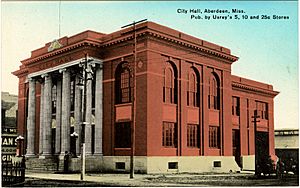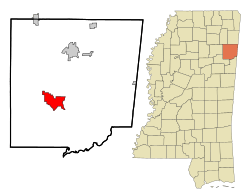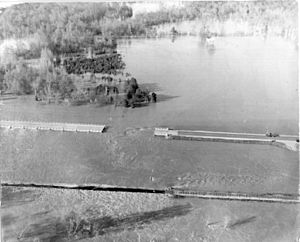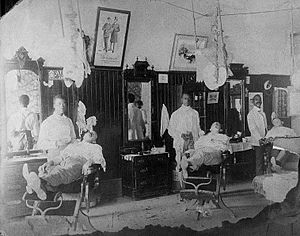Aberdeen, Mississippi facts for kids
Quick facts for kids
Aberdeen, Mississippi
|
||
|---|---|---|

Aberdeen City Hall (early 20th century)
|
||
|
||
| Motto(s):
"A Great Place to Live, Work and Play"
|
||

Location of Aberdeen, Mississippi
|
||
| Country | United States | |
| State | Mississippi | |
| County | Monroe | |
| Area | ||
| • Total | 12.37 sq mi (32.04 km2) | |
| • Land | 12.09 sq mi (31.31 km2) | |
| • Water | 0.28 sq mi (0.73 km2) | |
| Elevation | 230 ft (70 m) | |
| Population
(2020)
|
||
| • Total | 4,961 | |
| • Density | 410.34/sq mi (158.43/km2) | |
| Time zone | UTC-6 (Central (CST)) | |
| • Summer (DST) | UTC-5 (CDT) | |
| ZIP code |
39730
|
|
| Area code(s) | 662 | |
| FIPS code | 28-00180 | |
| GNIS feature ID | 2403058 | |
Aberdeen is a city in Monroe County, Mississippi, in the United States. It is the main town, also known as the county seat, of Monroe County. In 2020, about 4,961 people lived there.
Aberdeen is located right on the Tombigbee River. In the 1800s, it was one of Mississippi's busiest ports. Many goods, especially cotton, were traded here. For a while, Aberdeen was the second-largest city in Mississippi!
Today, Aberdeen still has many old buildings from that time. More than 200 of them are listed on the National Register of Historic Places. Each spring, people can visit these beautiful old homes, like The Magnolias, which was built in 1850.
Just outside the city, the Aberdeen Lock and Dam creates Aberdeen Lake. This lake is a fun place for outdoor activities. The lock and dam are part of the larger Tennessee-Tombigbee Waterway system.
Contents
History of Aberdeen
The first Europeans to explore the area around Aberdeen were part of Hernando DeSoto's expedition in 1540.
Aberdeen was first settled in 1834. It officially became a town in 1837. In 1849, it was chosen as the county seat when Monroe County was formed.
During the American Civil War, a small battle happened in Aberdeen on February 18, 1864. Union soldiers met Confederate forces and pushed them back. The Union army took control of Aberdeen. They also destroyed Confederate food and equipment.
Hiram Revels, who was the first African-American to serve as a United States senator, passed away in Aberdeen on January 16, 1901. He was attending a church meeting at the time.
Aberdeen's population has changed over the years. In 1910, about 3,708 people lived there. By 1950, the population had grown to 5,920. In 1980, it reached 7,184 people.
Geography and Location
Aberdeen is in the southwest part of Monroe County. The city center is on a small hill next to the Tombigbee River.
Major roads pass near or through Aberdeen:
 U.S. Highway 45 goes around the city. It leads north to Tupelo (about 35 miles away) and south to Columbus (about 27 miles away).
U.S. Highway 45 goes around the city. It leads north to Tupelo (about 35 miles away) and south to Columbus (about 27 miles away). Mississippi Highway 8 runs through the south side of the city. It goes northeast to Wise Gap and west to Houston.
Mississippi Highway 8 runs through the south side of the city. It goes northeast to Wise Gap and west to Houston. Mississippi Highway 25 also passes through the south side. It leads north-northeast to Amory and southwest to West Point.
Mississippi Highway 25 also passes through the south side. It leads north-northeast to Amory and southwest to West Point.
The city covers about 12.4 square miles (32.04 square kilometers). Most of this is land, but about 0.3 square miles (0.73 square kilometers) is water. The Tombigbee River and the Tennessee–Tombigbee Waterway flow through the eastern part of the city. The Aberdeen Lock and Dam is located within the city limits.

Aberdeen's Climate
Aberdeen has a climate with hot, humid summers. The winters are usually mild to cool. This type of weather is called a humid subtropical climate.
Population Information
| Historical population | |||
|---|---|---|---|
| Census | Pop. | %± | |
| 1870 | 2,022 | — | |
| 1880 | 2,339 | 15.7% | |
| 1890 | 3,449 | 47.5% | |
| 1900 | 3,434 | −0.4% | |
| 1910 | 3,708 | 8.0% | |
| 1920 | 4,071 | 9.8% | |
| 1930 | 3,925 | −3.6% | |
| 1940 | 4,746 | 20.9% | |
| 1950 | 5,290 | 11.5% | |
| 1960 | 6,450 | 21.9% | |
| 1970 | 6,507 | 0.9% | |
| 1980 | 7,184 | 10.4% | |
| 1990 | 6,837 | −4.8% | |
| 2000 | 6,415 | −6.2% | |
| 2010 | 5,612 | −12.5% | |
| 2020 | 4,961 | −11.6% | |
| U.S. Decennial Census | |||
2020 Census Details
In 2020, there were 4,961 people living in Aberdeen. There were 2,016 households and 1,195 families.
Here's a look at the different groups of people living in Aberdeen in 2020:
| Race | Number of People | Percentage |
|---|---|---|
| Black or African American | 3,504 | 70.63% |
| White | 1,247 | 25.14% |
| Native American | 10 | 0.2% |
| Asian | 17 | 0.34% |
| Pacific Islander | 1 | 0.02% |
| Other/Mixed | 127 | 2.56% |
| Hispanic or Latino | 55 | 1.11% |
2010 Census Details
In 2010, there were 5,612 people in the city. About 69.2% were African American and 28.8% were White. A small number of people were Native American, Asian, or from other backgrounds. About 1.0% of the population was Hispanic or Latino.
Education in Aberdeen
Students in Aberdeen attend schools that are part of the Aberdeen School District.
Media and Communications
Radio Stations
- 1240 WWZQ-AM
- 105.3 WACR-FM
Transportation and Infrastructure
Highways
Railroads
Several railway lines serve Aberdeen:
- Burlington Northern and Santa Fe Railway
- Alabama and Gulf Coast Railway
- Kansas City Southern Railway
Notable People from Aberdeen
Many interesting people have connections to Aberdeen, including:
- Joel M. Acker, who served in the Mississippi State Senate.
- Stephen Adams, a former member of the U.S. House and Senate.
- Steve Baylark, a running back in the United Football League.
- Guy Bush ("the Mississippi Mudcat"), a famous Major League Baseball pitcher.
- Oliver Darden, a basketball player for the University of Michigan.
- Reuben Davis, a Congressman and Confederate general.
- Wilma Cozart Fine, a well-known record producer.
- Samuel J. Gholson, a congressman, judge, and general.
- Joe Green, a former NFL defensive back.
- Ann Gregory, a talented golfer.
- Moses Hardy, who was once the oldest living American man and a World War I veteran.
- Reggie Kelly, a former NFL tight end.
- Albert King, a legendary blues guitarist.
- Fredrick McGhee, the first black lawyer in Minnesota.
- James Phelan Jr., a member of the U.S. House of Representatives.
- Roscoe Simmons, an orator and journalist.
- Eugene Sykes, a justice of the Supreme Court of Mississippi.
- Butch Thompson, a college baseball head coach.
- Andre Townsend, a former defensive end for the Denver Broncos.
- Jim Walden, a college football head coach.
- Channing Ward, a former NFL defensive tackle.
- Bukka White (Booker T. Washington White), a famous blues musician.
- Dwayne Whitfield, a former National Basketball Association player.
- Chris Willis, a former college football head coach.
Images for kids
See also
 In Spanish: Aberdeen (Misisipi) para niños
In Spanish: Aberdeen (Misisipi) para niños









